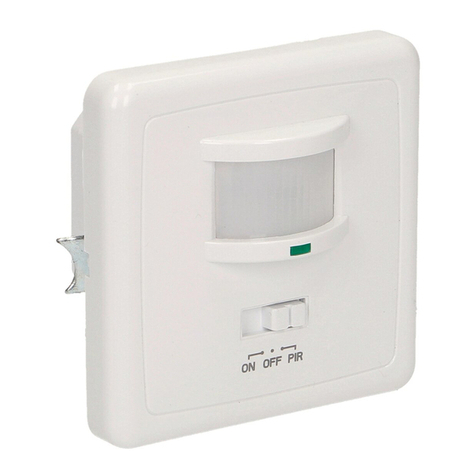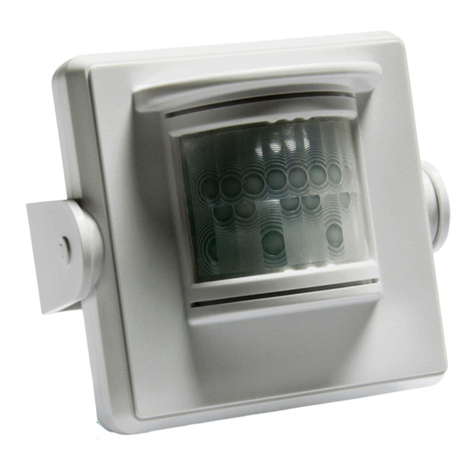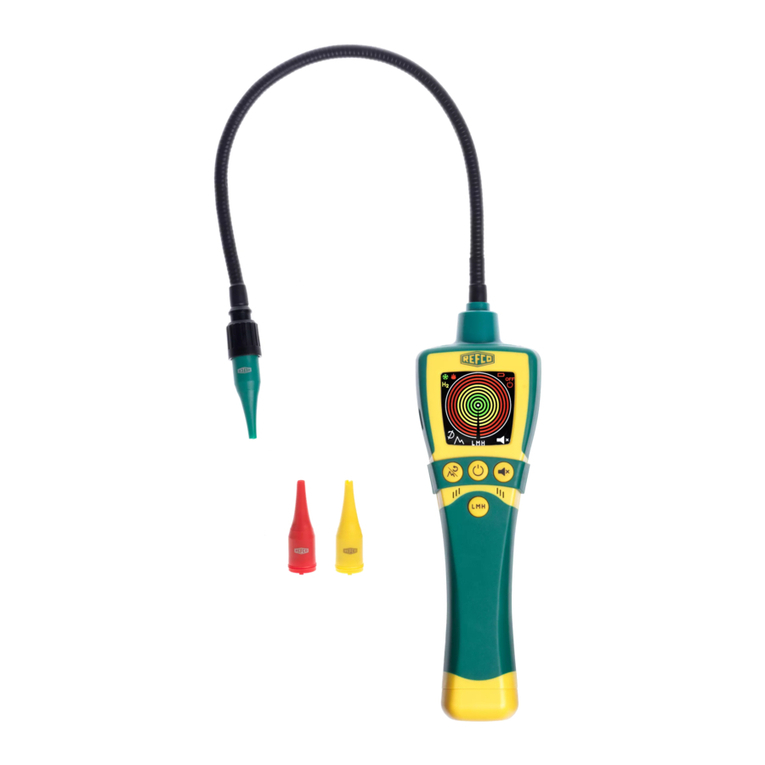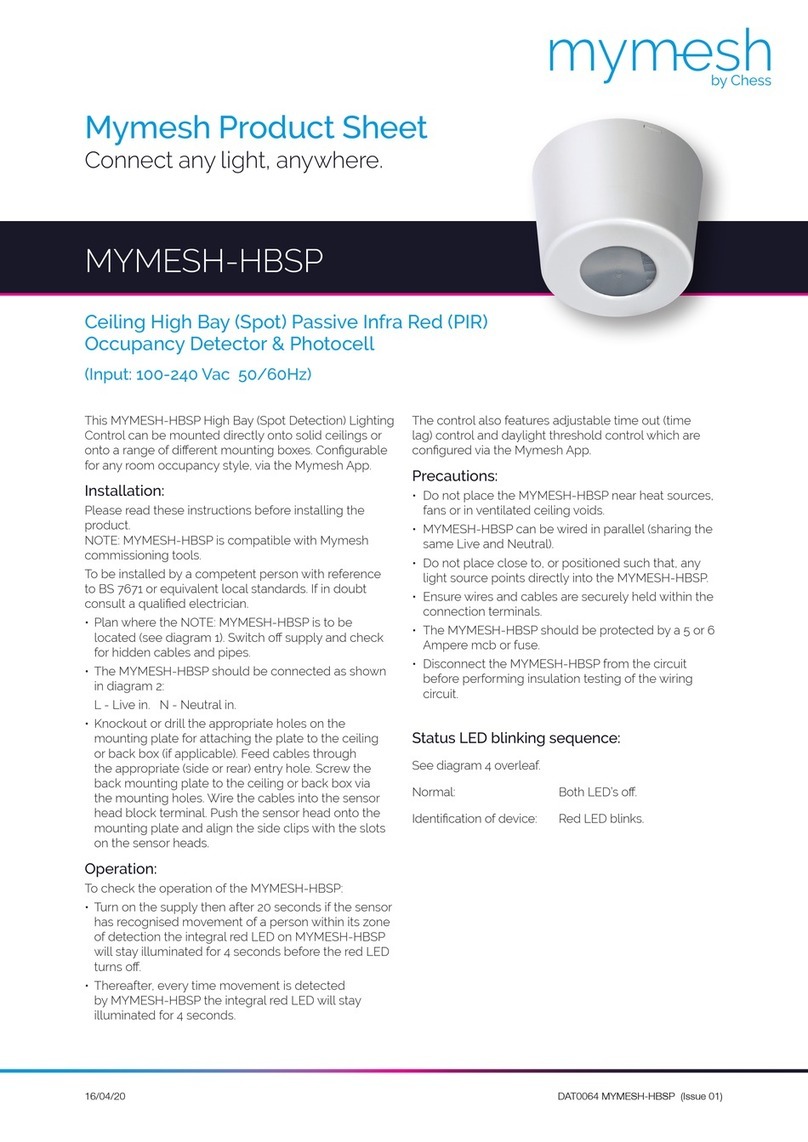Nohken VQ32 User manual

TS02-100095
INSTRUCTION MANUAL
FOR
TUNING FORK LEVEL SENSOR
MODEL: VQ32
Issued 2023-02-01

- ADD 1 -
Read this manual carefully for safe usage.
・ This manual applies to general purpose equipment. For equipment intended f or
use in potentially explosive atmospheres, see applicable manuals.
・ This manual contains important information on handling, inspect ion and
operation of the equipment indicated on the cover page. Before handling the
equipment, read this manual carefully.
・ Instructions in documents submitted by Nohken or its representative have
higher priorit y than those in this manual.
・ Keep this manual within easy access.
・ Depending on envir onment, the equipment may not satisfy specifications
shown in this manual. Check the application condit ions carefully beforehand.
・ Please contact our sales office for any questions or comments about the
equipment or this manual. Sales offices are shown on the back of the manual.
Safety Symbols:
WARNING
Means a potentially hazardous situation wh ich,
if necessar y precaut ions are not observed, can result
in death, serious inj ury and/or considerable mater ial
damage.
CAUTION
Means a hazardous situation which, if necessary
precautions are not observed, can result in minor or
moderate injury or damage to the device.
Means prohibited actions.
Means mandator y actions.

- ADD 2 -
WARNING
This equipment is NOT intended for use in potentia lly hazar dous
atmospheres. Never use it where flammable gas or vapor may be
present. Failure to observe this may result in ignition of flammable
gas or vapor, causing disaster.
Do not alter or disassemble the equipment, unless you have been
instructe d to do so by Nohken or its representative.
Failur e to obser ve this may result in:
- malf unction of or damage to the equipm ent or connected devices;
- ignition;
- electr ic shock or user injury.
Turn off the equipment bef ore wiring or inspection. Otherwise
leakage or short circuit ma y cause ign ition or electric shock.
After wiring is complete, always check f or its correctness. Wrong
wiring may cause:
- damage to or malfunction of the equipment or connected devices;
- ignition;
- electr ic shock or user injury.
Turn off the equipment immediately in case smok e, unusual smells
or sounds are noticed. Do not supply power until problems are
solved.

- ADD 3 -
CAUTION
Handle the equipment with care. Do not drop, throw, or give
a strong shock to avoid damage.
Observe operation conditions specified in the manual. Use outside
the specif ied conditions may resu lt in malf unction of or damage to
the equipment or connected devices, ignition, user injury, or
electric shock .
Perform operation tests before actual application to ensure
perf ormance. Install back-up instrume nts based on different
technologies if f ailure of this equipment is expected to resu lt in
a serious incident.
Check carefully for chemical compatibility of materials of
construct ion b ef ore installation.
Use the f lange, thread or somewhere close to the process
connectio n to handle the equipment. Do not use the terminal box
(hous ing) to a void dropping the equipment, and resultant damage
to the equipment or user inj ur y.
Equipment 50cm or longer:
Lay the equipment when not in use. Otherwise it may fall and
damage itself or things around it, and cause user injur y.
Always conn ect the protective terminal inside the housing
to the ground. (Ground resistance: 100Ωmax.)
Otherwise leak may occur to cause electr ic shock
when error occurs.
When connecting to inductive or lamp loads:
Ensure t he maximum voltage/current ratings will not be exceeded
to avoid damage to the relay contacts.
Use lightening arrestors or surge absorbers to prevent:
- malfunction, damage, or ig nition of the equipment and connected
instruments;
- electric shock or injury.

- ADD 4 -
INTRODUCTION
A) This manual applies to standard models. Please note that information in
this manual may not be applied to customized versions.
B) We are willing to help customers select a suitable model or provide
information about chemical compatibility of materials used, but the
customer is responsible for the decisions made.
C) We always welcome suggestions and comments about this manual.
Please contact our sales office when you have questions or comments.
D) Component replacement:
The equipment design is regularly reviewed and improved. The same
components therefore may not be available when replacement is required.
In such cases, different components or products may be supplied. Please
contact our sales office for detail.
E) The contents of this manual are subject to change without prior notice as
a result of improvement of the equipment.
WARRANTY & DISCLAIMER
A) Nohken warrants the equipment against defect in design or material, and
workmanship for a period of one (1) year from the date of original
shipment from Nohken’s factory.
B) Nohken will not assume liability for loss nor damage resulting from the
use of the equipment.
C) Nohken will not assume liability for damage resulting from:
C-a) not observing instructions in this manual;
C-b) installation, wiring, operation, maintenance, inspection, or storing in
a manner not outlined in this manual;
C-c) unauthorized alterations and repairs;
C-d) the use of or replacement with components not provided by Nohken;
C-e) devices or instrument other than those manufactured by Nohken;
C-f) the use not described in Chapter 1 Purpose of Use of the manual;
C-g) force majeure including, but not limited to, fire, earthquake, tsunami,
lightning strike, riot, commotion, war, armed conflict or terrorist
attack, radioactive pollution, act of God, governmental decisions or
actions, and compliance with laws and regulations.
THE PROVISIONS OF THIS SECTION DO NO LIMIT YOUR LEGAL RIGHTS.

Table of Contents
1. PURPOSE OF USE .................................................................... 1
2. DESCRIPTION ....................................................................... 1
2.1 Product Overview ............................................................... 1
2.2 Principle of Operation ......................................................... 1
3. SPECIFICATIONS .................................................................... 1
3.1 Model Numbering ................................................................ 1
3.2 Specifications ................................................................. 2
3.2.1 Common ..................................................................... 2
3.2.2 Model specific ............................................................. 3
3.3 Outline Drawing ................................................................ 5
4. HANDLING NOTES .................................................................... 6
5. INSTALLATION ...................................................................... 7
5.1 Unpacking ...................................................................... 7
5.2 Switching Point ................................................................ 8
5.3 Mounting ....................................................................... 8
5.4 Handling Notes ................................................................. 9
6. WIRING ........................................................................... 12
6.1 Cable ......................................................................... 13
6.2 Wiring ........................................................................ 13
6.3 Cable Inlet ................................................................... 16
6.4 Placing Cover ................................................................. 17
7. ADJUSTMENT ....................................................................... 18
7.1 Parts Name .................................................................... 18
7.2 Switches ...................................................................... 18
7.3 Modes Setting ................................................................. 19
8. MAINTENANCE AND INSPECTION ....................................................... 21
8.1 Maintaining Mounted Sensor .................................................... 21
8.2 Maintaining Dismounted Sensor ................................................. 22
8.3 Installation .................................................................. 22
8.4 Wiring ........................................................................ 22
8.5 Sensor Service Life ........................................................... 22
9. STORING .......................................................................... 22
9.1 Conditions .................................................................... 22
9.2 Precautions ................................................................... 22
10.TROUBLESHOOTING ................................................................. 23
11.GLOSSARY ........................................................................ 24

1
1. PURPOSE OF USE
Tuning Fork Level Sensor VQ is designed to detect and report material presence at a level on a tank
or piping. Do not use it for any other purpose.
2. DESCRIPTION
2.1 Product Overview
VQ is a compact level sensor ideal for integration into machinery. The wetted parts, the fork* and
process connection, are in 316L stainless steel to offer high corrosion resistance. The user can
check the status LED through the transparent cover without opening it.
2.2 Principle of Operation
The sensor incorporates a piezo-electric crystal* that oscillates the detecting element, the fork,
at a frequency. The frequency changes with the medium around the fork. The sensor electronics detects
this change in frequency, and gives an output to report presence or absence of the material.
3. SPECIFICATIONS
3.1 Model Numbering
VQ32-□ □ □ □
Code Surface finish
(blank)
-
B Super mirror finish (Buff #400, sanitary version only)
Code Insertion length
0
Standard
R threaded : 48mm
Flange : 54mm
Sanitary : 51mm (11/2S)
54mm (2S or larger)
X
Extended R threaded : 80 to 3000mm (1000mm max. for R1/2)
Flange : 80 to 3000mm
Sanitary : 80 to 3000mm (11/2S)
80 to 3000mm (2S or larger)
Code Output
0 2 wire
1 3 wire (NPN/PNP open collector)
2 Dry contact relay* (SPDT)*
Code Process connection
R R thread
F Flange*
S Sanitary fitting
Z Custom
* See
11. GLOSSARY
.

2
3.2 Specifications
3.2.1 Common
Model VQ32-R□0
VQ32-R□X
VQ32-F□0
VQ32-F□X
VQ32-S□0B
VQ32-S□XB
Measured material Liquids
Operating characteristics
Specific gravity 0.6 to 2.0 (sensitivity Lo ≧0.8, Hi <0.8)
Viscosity 0.2 mPa・s to 10 Pa・s
Switching point
(water, sensitivity=Lo)
Approx. 13.5 mm from tip (vertical)
Approx. 3 mm above the center line (horizontal)
See Fig,5-1 in section 5.2)
Hysteresis (water) Approx. 2 mm
Mechanical characteristics
Pressure (static) 6 MPa max. (excluding process connection)
Vibration resistance
(JIS C 60068-2-6)
10 to 58.1 Hz – half amplitude 0.15 mm
58.1 to 150 Hz – 20 m/s2 acceleration
10 to 150 Hz – 20 sweeps
Environmental
Working temperature
Process -40 to +150 ℃
Ambient -40 to +80 ℃ (no condensation)
Relative humidity 85 % max.
Protection class
Wetted parts IP68 (10 MPa static for 15 minutes)
Housing IP65/67
Material
Wetted parts 316L stainless steel
Housing Housing : glass reinforced PBT (with anti-static agent)
Cover : PC (clear) or
glass reinforced PBT (with anti-static agent)
optionally available
Process connection R 3/4 JIS 5K 25A ISO 11/2S or equivalent
Wetted parts maximum 17.3 mm 21.7 mm 17.3 mm 21.7 mm 17.3 mm 21.7 mm
Cable inlet G 1/2 or equivalent, 11 mm deep
Mass (approx.) 0.5 kg 1.8 kg
(L=1000mm
1.3 kg 2.6 kg
(L=1000mm)
0.7 kg 2 kg
(L=1000mm)
Housing rotation 300°

3
3.2.2 Model specific
(1) 2 wire (VQ32-□0□)
Operating characteristics
LED (red) operation Output ON
- Lights continuously
Output
OFF
- 1 flash per 3 seconds
Delay - 7 flashes per second
Overload - 3 flashes per second twice, and then goes out for 1 second
Error - 3 flashes per second 5 times, and then goes out for 1 second
Electric characteristics
Power supply 24 to 240 V AC ±10 %, 50/60 Hz
24 to 54 V DC ±10 %
Power consumption 0.1 VA at 24 V AC with output OFF (0.3 VA max.)
1.5 VA at 240 V AC with output OFF (132 VA max.)
0.1 W at 24 V DC with output OFF (0.3 W max.)
0.2 W at 54 V DC with output OFF (30 W max.)
Output 2 wire
- Operation and delay modes selectable
Delay timer Wet = ON Dry = ON
ON delay 0.5 to 30 sec., selectable
approx. 0.3 sec.
OFF delay approx. 0.3 sec. 0.5 to 30 sec., selectable
Output rating Load current: 12 to 500 mA AC/DC
Voltage drop: 12 V AC/DC max. with output ON
Insulation resistance 100 MΩ min. at 500 V DC, between power and E terminals
Withstand voltage 2200 V AC for 5 seconds, between power and E terminals
(2) 3 wire (VQ32-□1□)
Operating characteristics
LED (red) operation Load ON - Lights continuously
Load OFF - 1 flash per 3 seconds
Delay - 7 flashes per second
Error - 3 flashes per second 5 times, and then goes out for 1 second
Electric characteristics
Power supply 24 V DC ±10 %
Power consumption 0.1 W
Output 3 wire
- NPN open collector (OUTPUT 1)
- PNP open collector (OUTPUT 2)
- Operation and delay modes selectable
Delay timer Wet = ON Dry = ON
ON delay 0.5 to 30 sec., selectable
approx. 0.3 sec.
OFF delay approx. 0.3 sec. 0.5 to 30 sec., selectable
Output rating Load current : 100 mA DC max.
Load voltage : 26 V DC max. (OUTPUT 1)
Voltage drop : 1 V DC max. with load ON (OUTPUT 1)
2 V DC max. with load ON (OUTPUT 2)
Insulation resistance 100 MΩ min. at 500 V DC, between power/OUTPUT 1/PUTPUT 2 and E terminals
Withstand voltage 2200 V AC for 5 seconds, between power/OUTPUT 1/PUTPUT 2 and E terminals

4
(3) Relay (VQ32-□2□)
Operating characteristics
LED (red) operation Relay energized - Lights continuously
Relay de-energized - 1 flash per 3 seconds
Delay - 7 flashes per second
Error -
3 flashes per second 5 times, and then goes out
for 1 second
Electric characteristics
Power supply 100 to 240 V AC ±10%, 50/60 Hz
24 to 54 V DC ±10 %
Power consumption
(approx.)
0.5 VA at 100 V AC
1.5 VA at 240 V AC
0.1 W at 24 V DC
0.3 W at 54 V DC
Output Dry contact relay, SPDT
- Operation and delay modes selectable
Delay timer Wet = ON Dry = ON
ON delay 0.5 to 30 sec., selectable
approx. 0.3 sec.
OFF delay approx. 0.3 sec. 0.5 to 30 sec., selectable
Contact rating Maximum : 250 V, 3 A AC (resistive)
30 V, 3 A DC (resistive)
Minimum : 5 V 10 mA DC (resistive)
Insulation resistance
100 MΩ min. at 500 V DC, between power & E terminals, power & relay
terminals, relay & E terminals
Withstand voltage 2200 V AC for 5 seconds, between power & E terminals, power & relay
terminals, relay & E terminals

5
3.3 Outline Drawing
Threaded Flanged Sanitary
Standard
Extended
Cover
(top view)
① Cover – clear cover to check status LED with the cover closed.
② Cable inlet (G1/2, 11mm deep)
③ External earth terminal (M4)
④ Housing – has the electronics inside
⑤ Marking – indicates fork orientation
⑥ Threaded connection – process connection
⑦ Flange
⑧ Sanitary fitting – process connection
⑨ Extension pipe
⑩ Fork – detects material presence/absence
⑪ Status LED

6
4. HANDLING NOTES
Observe instructions below when handling the sensor, or malfunctioning or injury may result.
(1)
Lay the sensor on a flat surface. Do not stand it
to prevent it from falling.
Support the sensor with wood piece to avoid rolling,
or bent or damaged fork.
Always make sure the fork will not be damaged.
(2) Avoid corrosive atmosphere (NH3, SO2, Cl2
). Such
atmosphere may penetrate
the housing and damage
internal components.
(3) Avoid or protect against vibration.
(4) Wear gloves when the process temperature is +45℃
or higher, or +5℃ or lower to avoid injury.
(5) Handle the sensor with care.
Damage to the fork may
lead to malfunctioning.
(6) The housing can be rotated 300˚. Do not rotate it
any further to avoid damage.

7
5. INSTALLATION
WARNING
VQ32 is not intended for use in hazardous areas*. Never use it in areas
where flammable or explosive gases or vapors may be present.
5.1 Unpacking
(1)
Carefully unpack the sensor. Do not hold it by its
fork to avoid damage. Hold it by:
① Standard version: housing
② Extended
version: extension pipe and housing or
process connection
(2)
Sensors longer than 1500mm require two people to
carry them. Doing it alone is more likely to result
in accidents.
(3) Do not drop or damage the sensor. Handle with care.
(4) Check against the nameplate that the
sensor is what
you have
ordered. If not, please contact our sales
office.
(5) Check the sensor for visible damage. If any, p
lease
keep the packaging and contact our sales office.
* See
11. GLOSSARY
.

8
5.2 Switching Point
(1) Vertically mounted, with water - approximately
13.5mm from the fork tip
(2) Horizontally mounted, with water – approximately 3mm
above the center
Fig. 5-1
5.3 Mounting
Align the fork gap with the flow direction. Use the markings when orienting the sensor.
(1) Threaded version
Use a tool to mount the sensor. Hexagon on the thread
is of 41mm across flats.
Fig. 5-2
(2) Flanged version
Place the sensor flange on the tank flange, and secure
them using a suitable tool and fasteners according
to the applicable standards. Use a gasket suitable
for working conditions to prevent leak. Note that
fasteners and gaskets are optional.
Fig. 5-3
(3) Sanitary version
Use a clamp to mount this version. Select a gasket
suitable for the measured material.
Fig. 5-4

9
5.4 Handling Notes
CAUTION
Never alter the forks in any way to avoid malfunctioning or damage.
Do not drop or damage the sensor. Handle with care.
Make sure the fork protrudes into the tank or piping.
Otherwise the sensor may erroneously detect buildup on
the wall.
Clean the fork periodically. Buildup may adversely affect
operation.
Use the tool on the hexagon of the sensor when mounting threaded version.
Never
use the tool on the housing.
Avoid proximity to the inlet, outlet, agitator, or other high
flow or bubble sources. Such conditions may adversely affect
operation.

10
(1) For horizontal mounting, orient the sensor as the picture on the left in Fig. 5-4 show. Make
sure the markings on the hexagon face upwards and downwards.
Fig. 5-5
CAUTION
When measuring sticky material, the surfaces of the fork must be vertical
to reduce buildup on the fork.
(2) On piping, mount the sensor so that the fork is parallel to the flow to avoid cavitation between
the tines.
Fig. 5-6
Fig. 5-7
(3) Avoid bubbles. The sensor may erroneously detect them.

11
(4) Typical installation
Fig. 5-8
CAUTION
Allow clearance of at least 13mm between the fork tip and the tank/pipe
wall for reliable operation.
(5) In sticky material, response to wet-to-dry may be slower.
Response to dry-to-wet is not affected.
(6) Make sure the fork protrudes for at least 27mm in any
cases including small piping, and the fork tip is at
least 13mm away from the piping wall.
The sensor can be mounted on piping with inner
diameter 40mm or larger, but 57mm or larger piping
is desirable.
Fig. 5-9
(7) Housing can be rotated approximately 300˚.
Make sure that water will not enter inside through
the cable inlet.
Fig. 5-10
Fig.5-10

12
6. WIRING
WARNING
Disconnect power before wiring, or electric shock may result. Ignition or short
circuit may also result due to leakage or charged components contacting each other.
Do not startup sensors with fault in protective functions such as internal earth
or fuse. Otherwise device damage or injury may result.
Ensure correct voltage to avoid device damage or injury.
CAUTION
The housing can be rotated 300 degrees. Do not over-rotate. Rotating further than
specified may damage the sensor.
The terminal block accepts stranded cable with section area up to 2.5 mm2, or solid
cable with conductor diameter up to 1.6 mm. Internal and external earth terminals
accept stranded cable with section area up to 3.5 mm2, and solid cable with conductor
diameter up to 2.0 mm.
Use a surge protection device* if devices that can generate surges are in the vicinity
of the sensor.
Always connect the internal earth terminal to the ground. Connect the external earth
terminal to the ground as well if necessary.
(Ground resistance: 100Ω max.)
Do not exceed ratings for connected load to avoid damage to the sensor.
Add a suitable relay to switch loads exceeding the ratings.
Ratings:
- 2 wire (VQ32-□0□): 500mA AC/DC
- 3 wire (VQ32-□1□): 100mA DC
- Relay (VQ32-□2□): 250V, 3A AC (resistive), 30V, 3A DC (resistive)
Run the sensor cabling as far from power lines as possible to avoid induction. Use
a metal conduit if necessary.
Avoid proximity to sources of strong magnetic fields such as motors and solenoid
valves, or devices creating high frequency magnetic field such as ultrasonic
cleaners and transceivers.
* See
11. GLOSSARY
.

13
6.1 Cable
Strip the cable tip for 6mm. The sensor accepts conductor size of up to 2.5mm2.
Use cable with 0.75mm2 conductor to jumper terminals. Terminal screws have a combination head. Use
a slotted screwdriver of 0.6 x 3.5mm, or another suitable screwdriver.
If cable lugs are used, select ferrule terminals (insulated bar type cable lug) with 6mm insulation.
Internal and external earth terminals are M4 cross head screws. Use a suitable screwdriver.
6.2 Wiring
Properly connect the wire to the terminals. Use a screwdriver to ensure proper wiring.
Observe torque values below.
Torque: 0.4 to 0.5 N・m for terminals
1.2 N・m for internal earth
1.2 N・m for external earth
(1) 2 wire version (VQ32-□0□)
CAUTION
When connecting to a relay whose current rating 12mA or lower, or reset
current 5mA or lower, use a bleeder resistor in parallel with the load.
Always connect a relay or other device between the sensor and the power
supply. If power is directly connected, overcurrents will damage the
sensor.
When connecting to a relay, use one with a protection circuit or add
a surge protection device to protect the sensor from the reverse voltage.
When connecting to a relay, the sensor may instantly change output states
after power-up or recovery from power interruption. Beware that
latching relays will operate in these occasions.
Do not directly connect to a PLC or a timer relay. Use the relay (VQ32-
□2□) or 3 wire (VQ32-□1□) version instead.
Fig.6-1

14
[Bleeder resistor]
If the following applies to the connected relay, connect a bleeder resistor in parallel.
- rated for 12mA or less
- reset current*1 is 5mA or smaller
*1 Reset current = rated current of relay [mA] x release voltage [%] x 0.01
A. Select a resistor that satisfies the following two formulae.
Resistance R [kΩ] ≦
(Ira x Vrel x 0.008) x
Vra … (1)
5 - (Ira x Vrel x 0.008)
Ira
Ira = rated current in mA
Vra = rated voltage in V
Vrel= release voltage in %
12 ≦
Ira + Vra ≦ 500 … (2)
R*2
*2 Resistance R in kΩ must be smaller than the value obtained by formula 1.
B. Power rating of the bleeder resistor must satisfy the formula 3. Select a resistor with largest
possible power rating taking resistor heating into consideration.
Power [W] ≧
Vra2 x 5 … (3)
R x 1000
For example, when MY (OMRON) is used at 200V AC, 60Hz:
Rated current (Ira) – 5.3mA
Rated voltage (Vra) – 200V
Release voltage (Vrel) – 30%
Resistance R [kΩ] ≦ (5.3 x 30 x 0.008) x
200 (=12.8)
5 - (5.3 x 30 x 0.008) 5.3
12kΩ is most reasonable as the available resistor rating, so apply “12” to formula 2.
5.3 + 200 = 22
12
Power[W]≧ 2002 x 5 (=16.7)
12×1000
The resistor has to have 16.7W or larger power rating, so a 20W resistor must be selected.
■ Recommended devices
Table 6
Manufacturer Model
Rating
100V AC 200V AC 24V DC
OMRON Corporation MY 8.2kΩ, 10W
12kΩ, 20W 0.82kΩ, 5W
MM No bleeder resistor required.
IDEC Corporation RH
8.2kΩ, 10w
12kΩ, 20W
0.68kΩ, 5W
RY
Fuji Electric FA Com
ponents &
Systems Co., Ltd. HH5 0.82kΩ, 5W
Table of contents
Popular Security Sensor manuals by other brands
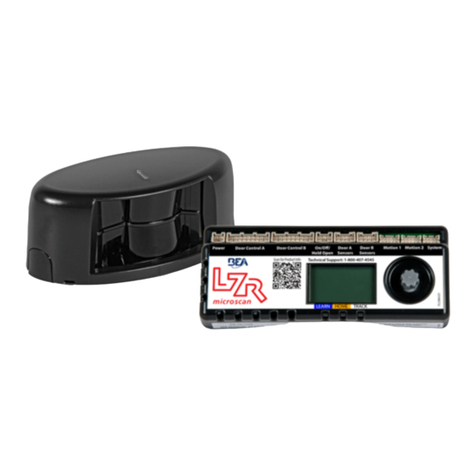
BEA
BEA LZR-MICROSCAN T manual
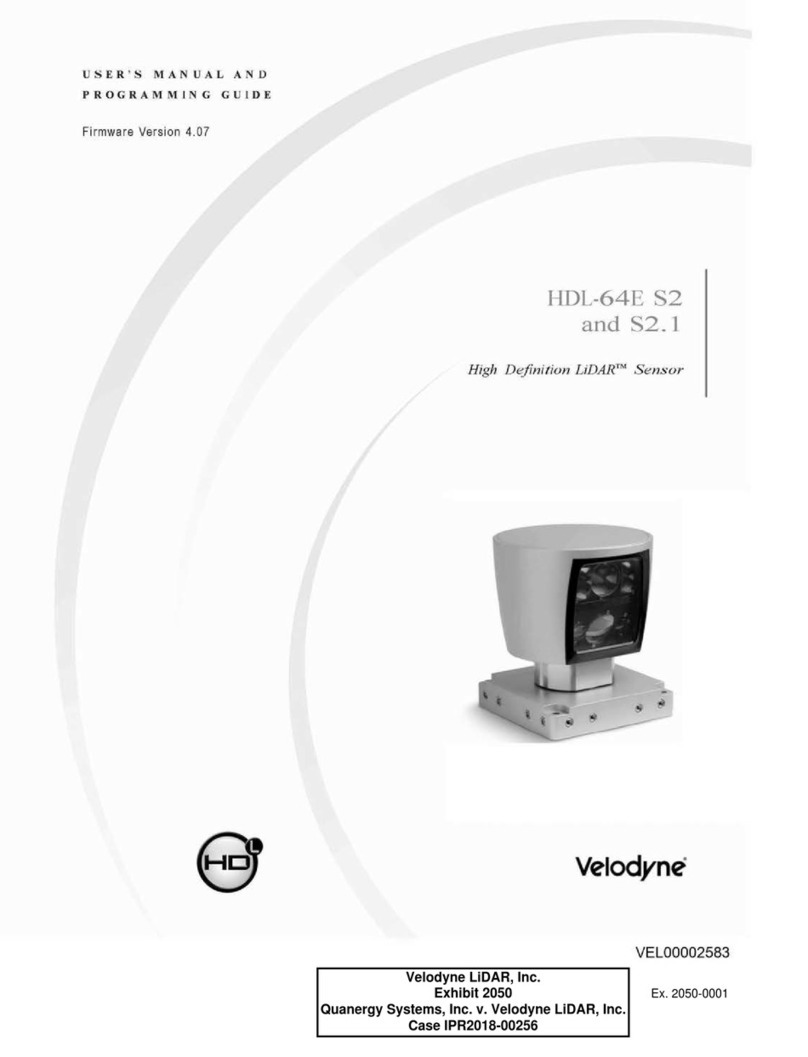
Velodyne
Velodyne HD HDL-64E S2 User's manual and programming guide
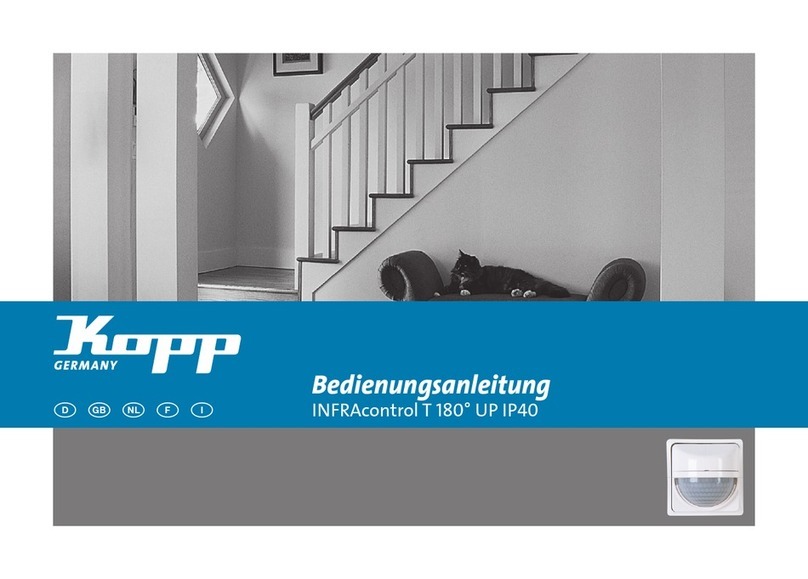
Kopp
Kopp INFRAcontrol R 180 UP IP40 operating instructions

Bosch
Bosch DS935LSN installation instructions
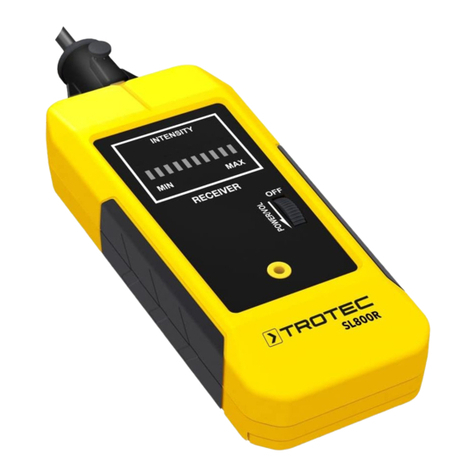
Trotec
Trotec SL800-SET operating manual
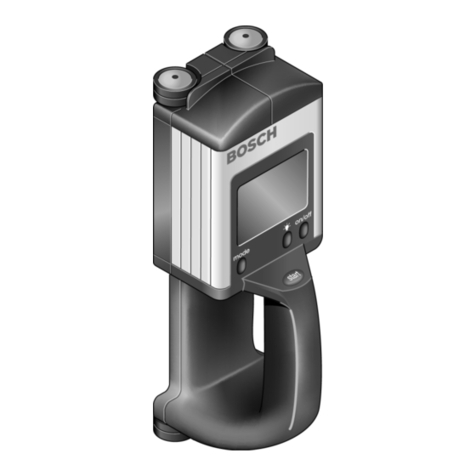
Bosch
Bosch PROFESSIONAL wallSCANNER D-TECT 100 concrete operating instructions



